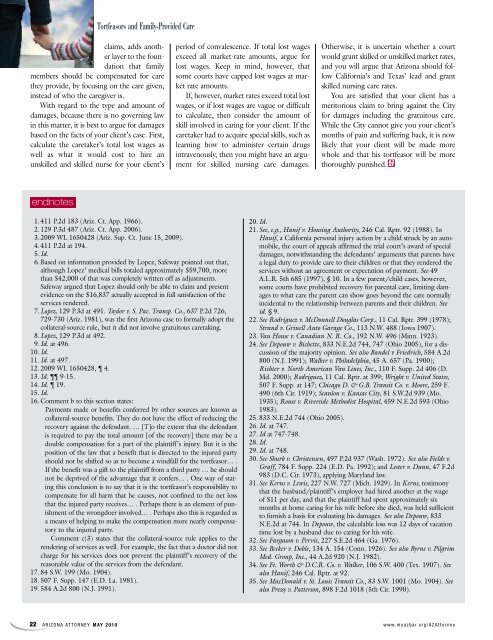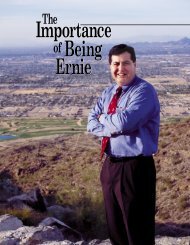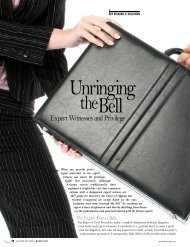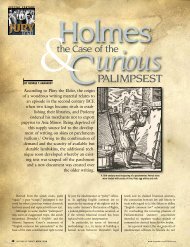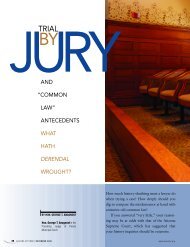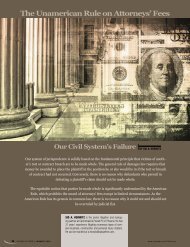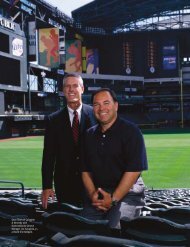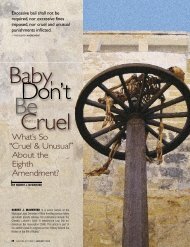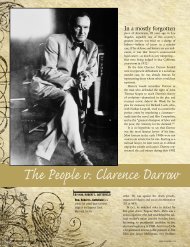The Ties That Bind: Tortfeasors and Family-Provided Care
The Ties That Bind: Tortfeasors and Family-Provided Care
The Ties That Bind: Tortfeasors and Family-Provided Care
You also want an ePaper? Increase the reach of your titles
YUMPU automatically turns print PDFs into web optimized ePapers that Google loves.
claims, adds another<br />
layer to the foundation<br />
that family<br />
members should be compensated for care<br />
they provide, by focusing on the care given,<br />
instead of who the caregiver is.<br />
With regard to the type <strong>and</strong> amount of<br />
damages, because there is no governing law<br />
in this matter, it is best to argue for damages<br />
based on the facts of your client’s case. First,<br />
calculate the caretaker’s total lost wages as<br />
well as what it would cost to hire an<br />
unskilled <strong>and</strong> skilled nurse for your client’s<br />
endnotes<br />
<strong>Tortfeasors</strong> <strong>and</strong> <strong>Family</strong>-<strong>Provided</strong> <strong>Care</strong><br />
1.411 P.2d 183 (Ariz. Ct. App. 1966).<br />
2.129 P.3d 487 (Ariz. Ct. App. 2006).<br />
3.2009 WL 1650428 (Ariz. Sup. Ct. June 15, 2009).<br />
4.411 P.2d at 194.<br />
5.Id.<br />
6.Based on information provided by Lopez, Safeway pointed out that,<br />
although Lopez’ medical bills totaled approximately $59,700, more<br />
than $42,000 of that was completely written off as adjustments.<br />
Safeway argued that Lopez should only be able to claim <strong>and</strong> present<br />
evidence on the $16,837 actually accepted in full satisfaction of the<br />
services rendered.<br />
7.Lopez, 129 P.3d at 491. Taylor v. S. Pac. Transp. Co., 637 P.2d 726,<br />
729-730 (Ariz. 1981), was the first Arizona case to formally adopt the<br />
collateral-source rule, but it did not involve gratuitous caretaking.<br />
8.Lopez, 129 P.3d at 492.<br />
9.Id. at 496.<br />
10. Id.<br />
11. Id. at 497.<br />
12. 2009 WL 1650428, 4.<br />
13. Id. 9-15.<br />
14. Id. 19.<br />
15. Id.<br />
16. Comment b to this section states:<br />
Payments made or benefits conferred by other sources are known as<br />
collateral-source benefits. <strong>The</strong>y do not have the effect of reducing the<br />
recovery against the defendant. … [T]o the extent that the defendant<br />
is required to pay the total amount [of the recovery] there may be a<br />
double compensation for a part of the plaintiff’s injury. But it is the<br />
position of the law that a benefit that is directed to the injured party<br />
should not be shifted so as to become a windfall for the tortfeasor… .<br />
If the benefit was a gift to the plaintiff from a third party … he should<br />
not be deprived of the advantage that it confers… . One way of stating<br />
this conclusion is to say that it is the tortfeasor’s responsibility to<br />
compensate for all harm that he causes, not confined to the net loss<br />
that the injured party receives… . Perhaps there is an element of punishment<br />
of the wrongdoer involved… . Perhaps also this is regarded as<br />
a means of helping to make the compensation more nearly compensatory<br />
to the injured party.<br />
Comment c(3) states that the collateral-source rule applies to the<br />
rendering of services as well. For example, the fact that a doctor did not<br />
charge for his services does not prevent the plaintiff’s recovery of the<br />
reasonable value of the services from the defendant.<br />
17. 84 S.W. 199 (Mo. 1904).<br />
18. 507 F. Supp. 147 (E.D. La. 1981).<br />
19. 584 A.2d 800 (N.J. 1991).<br />
period of convalescence. If total lost wages<br />
exceed all market-rate amounts, argue for<br />
lost wages. Keep in mind, however, that<br />
some courts have capped lost wages at market<br />
rate amounts.<br />
If, however, market rates exceed total lost<br />
wages, or if lost wages are vague or difficult<br />
to calculate, then consider the amount of<br />
skill involved in caring for your client. If the<br />
caretaker had to acquire special skills, such as<br />
learning how to administer certain drugs<br />
intravenously, then you might have an argument<br />
for skilled nursing care damages.<br />
Otherwise, it is uncertain whether a court<br />
would grant skilled or unskilled market rates,<br />
<strong>and</strong> you will argue that Arizona should follow<br />
California’s <strong>and</strong> Texas’ lead <strong>and</strong> grant<br />
skilled nursing care rates.<br />
You are satisfied that your client has a<br />
meritorious claim to bring against the City<br />
for damages including the gratuitous care.<br />
While the City cannot give you your client’s<br />
months of pain <strong>and</strong> suffering back, it is now<br />
likely that your client will be made more<br />
whole <strong>and</strong> that his tortfeasor will be more<br />
AZ<br />
thoroughly punished. AT<br />
20. Id.<br />
21. See, e.g., Hanif v. Housing Authority, 246 Cal. Rptr. 92 (1988). In<br />
Hanif, a California personal injury action by a child struck by an automobile,<br />
the court of appeals affirmed the trial court’s award of special<br />
damages, notwithst<strong>and</strong>ing the defendants’ arguments that parents have<br />
a legal duty to provide care to their children or that they rendered the<br />
services without an agreement or expectation of payment. See 49<br />
A.L.R. 5th 685 (1997), § 10. In a few parent/child cases, however,<br />
some courts have prohibited recovery for parental care, limiting damages<br />
to what care the parent can show goes beyond the care normally<br />
incidental to the relationship between parents <strong>and</strong> their children. See<br />
id. § 9.<br />
22. See Rodriguez v. McDonnell Douglas Corp., 11 Cal. Rptr. 399 (1978);<br />
Str<strong>and</strong> v. Grinell Auto Garage Co., 113 N.W. 488 (Iowa 1907).<br />
23. Van House v. Canadian N. R. Co., 192 N.W. 496 (Minn. 1923).<br />
24. See Depouw v. Bichette, 833 N.E.2d 744, 747 (Ohio 2005), for a discussion<br />
of the majority opinion. See also B<strong>and</strong>el v Friedrich, 584 A.2d<br />
800 (N.J. 1991); Walker v. Philadelphia, 45 A. 657 (Pa. 1900);<br />
Richter v. North American Van Lines, Inc., 110 F. Supp. 2d 406 (D.<br />
Md. 2000); Rodriguez, 11 Cal. Rptr. at 399; Wright v. United States,<br />
507 F. Supp. at 147; Chicago D. & G.B. Transit Co. v. Moore, 259 F.<br />
490 (6th Cir. 1919); Scanlon v. Kansas City, 81 S.W.2d 939 (Mo.<br />
1935); Rouse v. Riverside Methodist Hospital, 459 N.E.2d 593 (Ohio<br />
1983).<br />
25. 833 N.E.2d 744 (Ohio 2005).<br />
26. Id. at 747.<br />
27. Id at 747-748.<br />
28. Id.<br />
29. Id. at 748.<br />
30. See Shurk v. Christensen, 497 P.2d 937 (Wash. 1972). See also Fields v.<br />
Graff, 784 F. Supp. 224 (E.D. Pa. 1992); <strong>and</strong> Lester v. Dunn, 47 F.2d<br />
983 (D.C. Cir. 1973), applying Maryl<strong>and</strong> law.<br />
31. See Kerns v. Lewis, 227 N.W. 727 (Mich. 1929). In Kerns, testimony<br />
that the husb<strong>and</strong>/plaintiff’s employer had hired another at the wage<br />
of $11 per day, <strong>and</strong> that the plaintiff had spent approximately six<br />
months at home caring for his wife before she died, was held sufficient<br />
to furnish a basis for evaluating his damages. See also Depouw, 833<br />
N.E.2d at 744. In Depouw, the calculable loss was 12 days of vacation<br />
time lost by a husb<strong>and</strong> due to caring for his wife.<br />
32. See Fargason v. Pervis, 227 S.E.2d 464 (Ga. 1976).<br />
33. See Becker v. Doble, 134 A. 154 (Conn. 1926). See also Byrne v. Pilgrim<br />
Med. Group, Inc., 44 A.2d 920 (N.J. 1982).<br />
34. See Ft. Worth & D.C.R. Co. v. Walker, 106 S.W. 400 (Tex. 1907). See<br />
also Hanif, 246 Cal. Rptr. at 92.<br />
35. See MacDonald v. St. Louis Transit Co., 83 S.W. 1001 (Mo. 1904). See<br />
also Pressy v. Patterson, 898 F.2d 1018 (5th Cir. 1990).<br />
22 A R I Z O N A AT T O R N E Y M AY 2 0 1 0 w w w. m y a z b a r. o r g / A Z A t t o r n e y


